Problem Sets
for Math 111
Lesson1: Points & Coordinates 
1.
What are the
coordinates of the points on the graph
2.
Draw Points at 7,2, and 3,5.
3.
What is the
distance between:
7,2 and 3,2
3,5 and 3,2
7,2 and 3,5
4.
Draw points at: -5,8 8,-4 -7,-6 What is the slope of the line between: every
pair of points.
5.
section 1.2 pages
22-23 ex. 1,2,5,6,7,8
6.
section 1.2 pages
22 ex. 21-38
Lesson 2: Functions
Fuel Efficiency
The

1.
Explain why the
efficiency is a function of the year (why is year the independent variable).
2.
If F(year) is the
fuel efficiency function:
3.
F(1985) = ?
4.
F(1992) = ?
5.
F(?) = 18.20
6.
F(?) = 21.69
7.
The empirical
function describes just the data that is collected but does not consider
the values that were not presented. What is the domain and range of the
empirical fuel efficiency function?
8.
The actual
function is the values that could have been measured even if no measure was
taken. What do you think is the domain and range of the actual function? Why?
9.
Functions and
Tables: Text Section 1.1 page 7-10 ex 8,9,23,24,31,32
10. Functions and Graphs: Text Section 1.1
pages 7-10 ex. 10,11,12,13,19,20,25,28
11. Word Problems for Functions: Text Section 1.1
pages 7-10 ex. 21,22,33,34
Lesson 3: Slopes
Driving Excitement
As
you drive, your friend times how long it takes you to cover miles; he produces
this table for you which you find quite distracting:
|
|
(r) |
(s) |
(t) |
|
Minutes |
2 |
8 |
10 |
|
Miles |
1 |
4 |
5 |
1.
Write these
numbers as ordered pairs with the minutes as the independent variable.
2.
On your graph
paper, graph these pairs. How do you set up the axes? Do the three points line
up?
3.
What are the
slopes between all three points: r&s, s&t, and r&t?
4.
Draw the line
through the three points. Can you find an equation for this line?
5.
How much time does
it take to go 4 miles? 3 miles? 6 miles?
6.
How far can the
car go after 2 minutes? 4 minutes? 9 minutes?
7.
Calculating
Slope: Section 1.2 pages 15-18 ex. 1,2,15,16,18,19
8.
Slope from
tables: Section 1.2 pages 15-18 ex.3,4,21,25,26
Lesson 4: Linear Functions
Part
1: Algebraically
- Find the intercepts of the line through these points
with the specified slopes:
|
Point |
Slope |
|
(2,6) |
-3 |
|
(3,-5) |
-2 |
|
(6,7) |
2 |
|
(6,8) |
1/3 |
- Find the slope and intercepts of the line through
these pairs of points:
|
Point 1 |
Point 2 |
|
(-1,1) |
(3,9) |
|
(2,6) |
(5,3) |
|
(6,8) |
(-2,4) |
|
(3,-5) |
(-1,7) |
|
(6,7) |
(2,7) |
1.
Linear
Functions from tables: Section 1.3
page 25-27 ex 1,2,3,4,5,6,13,17,22,24,25
2.
Linear
Function Word Problems: Section 1.3
pages 26-27 ex. 14,15,16,19,20,21,26,27,28
3.
Linear
Functions from Points: Section 1.4 page
33 ex.16,17,18,19,20,21,22,23
4.
Linear
Functions from Tables: Section 1.4 page 33 ex. 24,25,26,27
5.
Linear
Function Word Problems: Section 1.4 pg 34-36 prob
38,39,40,41,42,47,48,49
6.
Freezing is 32
degrees Fahrenheit but 0 degrees Celsius. Boiling is 212 degrees Farenheight but 100 degrees Celsius. What is the Formula to
translate Celsius to Farenheight? What is the Formula
to translate Farenheight to Celsius? Why do we care?
Lesson 5: Linear Intersections
Intersect Algebraically
and graphically these lines:
Intersect Algebraically and graphically
these lines:
![]()
1. y=2x+3 and
y=3x+6
![]()
2. y=2x-3 and y= -x+3
![]()
3. slope 2 through (2,6) and linethrough (3,2) and (7,6)
![]()
4. y= -2x+5
and slope -4 through (3,5)
![]()
5. y = ½x+3 and
slope 1 through (-2,3)
![]()
6. Linear Intersection Word Problems: Section 1.5 page 43
ex. 19,20
7. At the concert, you can sell 6 copies of your poster at
$100 and 96 copies at $10 a piece. If you have time to
make 42 copies before the concert then how much should you charge to sell all
of them? If you charged $1 more would you make more money?
8.
a. If you charge $5 for a chicken you’ll sell 500 chickens
but if you charge $4 for a chicken you’ll sell 800 chickens. What is the linear demand function for chickens.
b. You can get 400 chickens for $1.75 but the next 600 are $2 (more
expensive supplier). What is the supply
function for chickens?
c. What is the equilibrium price for chickens? What is the equilibrium demand?
9.
a. If you charge $1 for a quarter pound burger you’ll sell
5000 burgers but if you charge $0.75 for a quarter pound burger you’ll sell
8000 burgers. What is the linear demand
function for burgers.
b. You can get 1 ton (2000 pounds of burger meat) for
$1000 but the next ton is $1500 (more expensive supplier) (two tons will thus
cost $2500, what will each ton cost?). What
is the supply function for burgers
c. From a ton of burger meat you can make 8000 quarter pounders.What is the equilibrium price for burgers? What is the equilibrium demand?
10.
a. You can sell 1000 doughnuts at $1.50 a piece but if you
charge $1.75 you will sell 750. What is
the demand function for donuts.
b. The cheapest bakery supplier will supply dough and
fillings for 200 doughnuts at a price of $0.35 a doughnut (total price
$70). The next cheapest can supply 300
doughnuts at a price of $0.50 a doughnut.
How much does it cost in total to supply dough and fillings for 500
doughnuts? How much per doughnut? What is the supply function for doughnuts?
c. What is the equilibrium price for doughnuts? What is the equilibrium demand?
Lesson 6: Quadratics
1. Quadratic Algebra Problems Section 3.2 pages
115-116 ex. 1,2,3,4,5,6,26,27,
2. Quadratic Word Problems Section 3.1 pages 116
ex. 30,31
3. If you charge $20 your store sells 500 crystals a year.
When you raise the price by $1 you sell 10 less, if you lower the price by $1
you sell 10 more. To produce the crystals costs $1000 fixed costs and $5 of
materials for each crystal. How much do you charge to maximize revenue (total
money the store collects)? How do you charge to maximize your profits
(revenue-manufacturing costs)? Whats the maximum
price that earns you more than $5000?
4. You can sell 30 paintings at $20 and reducing the price
by $2 allows you to sell 10 more paintings.
You can get supplies for 15 paintings from one supplier at $6 a
painting. You can get supplies from
another supplier for 30 paintings at $7.50 a painting. What should you charge to maximize profit?
Lesson 7: Quadratic Intersections
1. Find the intersection points between these curves -
Graphically and Algebraically:
|
y=x2-4x+7 |
y=x+3 |
|
y=x2-4x+7 |
y=-x+5 |
|
y=x2-4x+7 |
y=x2-2x+1 |
|
y=x2-4x+7 |
y=x2-12x+41 |
|
y=x2-2x+1 |
y=-x2+10x-15 |
|
y=x2-2x+1 |
y=-x2+6x+1 |
Lesson 8: Finding Quadratics
1. find the quadratic through these triples: (See worksheet above).
|
1,2 |
2,3 |
3,6 |
|
-1,2 |
2,-1 |
3,-6 |
|
1,5 |
-2,-3 |
3,6 |
|
1,-2 |
-2,4 |
3,-6 |
Lesson 9: Rational Functions
1.
Rational
Function Formulae Problems: Section 11.5 page 465 ex 1,2,3,4,5,6,7,8
2.
Find the
asymptotes of
1.
![]()
2.
![]()
3.
![]()
4.
![]()
5.
![]()
6.
![]()
Lesson 10: Composition and Inverse of Functions
1.
Function
Composition Table Problems: Section 10.1 page 401-404 ex.6,7,28,29,30,55
2.
Function
Composition Formulae Problems: Section 10.1 page 401-404 ex.1,2,3,9,9,10,11,12,13,62
3.
Function
Composition Word Problems: Section 10.1 pages 404 ex. 56
4.
Function
Inverse Formula Problems Section 10.2 page 411-414 ex.15,16,17,18,19,20,21,22,23,24,25,26
5.
Function
Inverse Word Problems: 35,36,37,38
![]() ,
, ![]() what is
what is ![]() ,
,![]() ,
,![]() ,
,![]()
![]() ,
, ![]() what is
what is ![]() ,
,![]() ,
,![]() ,
,![]()
8.
Find the
inverse of:
1.
![]()
2.
![]()
3.
![]()
4.
![]()
5.
![]()
![]() ,
, ![]() what is
what is ![]() , show
, show ![]() , what is
, what is ![]() , show
, show ![]()
![]() ,
, ![]() what is
what is ![]() , show
, show ![]() , what is
, what is ![]() , show
, show ![]()
11. Demand functions tell you how much of a product such as cheese you can
sell at a specified price. They have negative slopes, why? Interpret the
inverse function of demand. Discuss who might want to know it. What will its
slope be? Why?
Lesson 11: Exponential Functions
1. Calculate: 34, (1/3)4, (2/3)4,
3-4, (1/3)-4, (2/3)-4
2. Express as simply as possible: (a2)(a3),
(a3)(a-2), a-2b-2, a3b-3,
(d2)3,d23, (n-3k6)2/3
3.
Exponential Function
Problems: Section 4.1 page136-137. ex. 18,21,23,24,25,26,27
4.
Exponential Word
Problems: Section 4.1 pages 136-138 ex. 19,20,29,30,31,32,33,35,36,37,38,39,40,41,45,46,47,48
5. Compound Interest Problems: Section 4.4
page.156 ex. 1,2,3,4,5,6,7,8,9,10,11,12,13,14
6. Compound Interst Word
Problems: Section 4.4 pages 156 ex. 15,16,17,18,19,20,21,22
Section 4.5 page 165 ex. 30,31,32,33,36,37,38,39,40,45,46
Lesson 12: Logarithms
1. Logarithm Algebra Problems Section 5.1 page
184 ex 1,2,3,4,5,6,19,20
2. Logarithm Equation problem: Section 5.1 page 187 ex 34,35,37,38,39,40
3.
a. If you charge $5 for a chicken you’ll sell 500 chickens
but if you charge $4 for a chicken you’ll sell 800 chickens. What is the exponential demand function for chickens.
b. You can get 400 chickens for $1.75 but the next 600 are $2 (more
expensive supplier). What is the
exponential supply function for chickens?
c. What is the equilibrium price for chickens? What is the equilibrium demand?
4.
a.
If you charge $1 for
a quarter pound burger you’ll sell 5000 burgers but if you charge $0.75 for a
quarter pound burger you’ll sell 8000 burgers.
What is the exponential demand function for burgers.
b.
You can get 1 ton
(2000 pounds of burger meat) for $1000 but the next ton is $1500 (more
expensive supplier) (two tons will thus cost $2500, what will each ton cost?). What is the exponential supply function for
burgers
c.
From a ton of
burger meat you can make 8000 quarter pounders.What
is the equilibrium price for burgers?
What is the equilibrium demand?
5.
a.
You can sell 1000
doughnuts at $1.50 a piece but if you charge $1.75 you will sell 750. What is the exponential demand function for donuts.
b.
The cheapest
bakery supplier will supply dough and fillings for 200 doughnuts at a price of
$0.35 a doughnut (total price $70). The
next cheapest can supply 300 doughnuts at a price of $0.50 a doughnut. How much does it cost in total to supply
dough and fillings for 500 doughnuts?
How much per doughnut? What is
the exponential supply function for doughnuts?
c.
What is the
equilibrium price for doughnuts? What is
the equilibrium demand?
Lesson 13: Trigonometry Definitions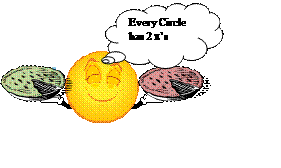
1. How many radians is 60o, 30o, 15o,
135o, 400o
2. Show where each of these lie on the unit circle.
3. How many degrees in p radians, p/4 radians, 3p/8 radians, 1
radian, 7 radians.
4. Show approximately where each of these lie on the unit
circle.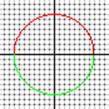
5. Radians Degrees Problems Section 8.1 pages
322-323 ex. 1,2,3,4,5,6,7,8,9,10,11,12
6. What is the sin, cos and tan
of the angle that the line y= x makes with the line y=0.
7. What is the sin, cos and tan
of the angle that the line y= 2x makes with the line y=0.
8. What is the sin, cos and tan
of the angle that the line y= ½x makes with
the line y=0.
9. What is the sin, cos and tan
of the angle that the line y= -x makes with the line y=0.
10. What is the sin, cos and tan
of the angle that the line y= -2x makes with the line y=0.
11. What is the sin, cos and tan
of the angle that the line y= -2x makes with the line x=0.
12. What is the sin, cos and tan
of the angle that the line y= x makes with the line x=0.
13. What is the sin, cos and tan
of the angle that the line y= ½x makes with the line x=0.
Lesson 14: Trigonometry Functions
1. Build these tables:
|
|
-p /2 |
-p /4 |
0 |
p/4 |
p/2 |
3p /4 |
p |
5p /4 |
3p /2 |
7p /4 |
2p |
|
Sin(x) |
. |
. |
. |
. |
. |
. |
. |
. |
. |
. |
. |
|
Cos(x) |
. |
. |
. |
. |
. |
. |
. |
. |
. |
. |
. |
|
2sin(x) |
. |
. |
. |
. |
. |
. |
. |
. |
. |
. |
. |
|
Sin(2x) |
. |
. |
. |
. |
. |
. |
. |
. |
. |
. |
. |
|
-cos(x) |
. |
. |
. |
. |
. |
. |
. |
. |
. |
. |
. |
2. Use the tables to graph sin(x), cos(x),
2sin(x), sin(2x), - cos(x).
3. Give the amplitude, frequency, and altitude for each of
the functions below
4. (each x box is p/4 radians):
(a) 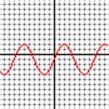 (b)
(b)
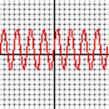 (c)
(c)
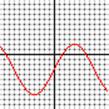
Graph each of these functions:
5. · sin(2x )
6. · -cos(-x)
7. · 3cos(x+p ) +2
8. · 2sin(2x +p /2)-2
9.
Trigonometric
function graphing Problems: Section 8.2 page 330-333
ex.1,2,3,4,9,10,11,12,13,14,17,18,19,20
Lesson 15: Trigonometric Inverse
1.
Section 8.4 page
347-349 ex. 1,2,3,4,5,6
© David B. Sher 2001